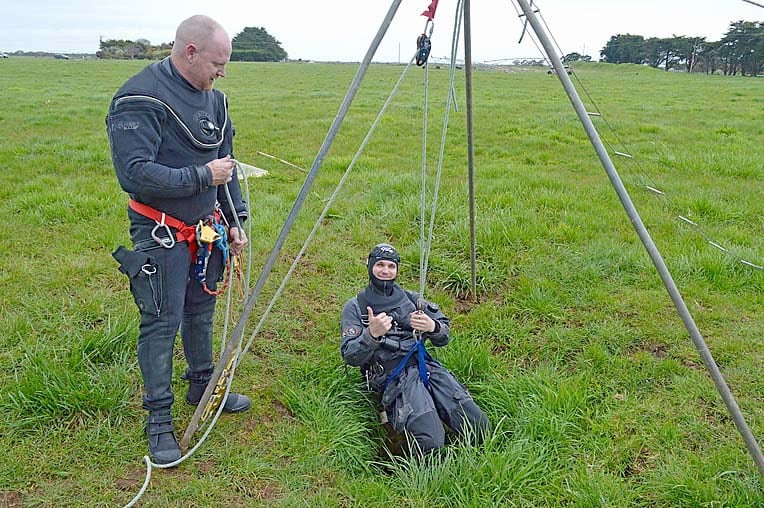

AS we cautiously drop into the depths, I glance up to see daylight shining through a small hole far above us, knowing it is the only way out of this water-filled cavern.
Venturing deeper, the sheer size and scale of the main chamber becomes apparent – spanning 140 metres across with a width of around 80 metres at its narrowest.
At a depth of around 36 metres we encounter the top of a rock pile from where two large tunnels can be followed.
A northwestern tunnel to a depth of around 80 metres and the eastern to a maximum depth of 124 metres.
Who would have thought we were diving this football field-sized sinkhole beneath an otherwise unremarkable paddock on the outskirts of Mount Gambier?
Known as The Shaft, the cavern’s name was derived from the bright beam of sunlight that cuts through the hole on a summer day, illuminating parts of the depths below.
“It is a truly spectacular sight to behold when you are floating at 40 metres and a shaft of bright sunlight beams through that little hole way above you,” Cave Divers Association of Australia (CDAA) instructor and The Shaft dive guide Tim Payne told The Border Watch.
“It lights up the cavern.”
The entrance to this privately-owned site is nothing more than a small hole in the ground, measuring around a metre in diameter.
The hole enters into a large dry chamber which drops to about seven metres, where it meets the water’s surface.
Because of the size of the hole, cave divers and equipment are lowered into the chamber separately with a pulley-system.
Divers don their gear on the water’s surface before descending.
“The Shaft is truly one of the jewels of the region and on the wish-lists of cave divers across the world,” Dr Payne said.
“Its unique location, crystal-clear water and scale are factors contributing to its status as a premium site.
“The visibility is such that divers can be seen from end-to-end of the main chamber.
“American cave diving pioneer and author the late Sheck Exley was one of many international visitors who dived the site.”
According to cave diver and CDAA life member Peter “Puddles” Horne, the cave is believed to have been discovered in the late 1930s when a plough-horse stumbled after putting its hoof through the small, dirt-filled tube entrance.
All that was immediately known was that a drop-line lowered through the original 30cm diameter hole revealed water about six metres below the surface and an ultimate floor depth of about 36 metres.
Mr Horne said is was not until the mid-1960s that a local diver climbed down the rain-enlarged 80cm tube into the cave’s 17 metre-wide lake chamber and made the first descent to a depth of about 21 metres.
The first truly representative map of the “bottomless” cavern was made in 1984 after the newly-formed CDAA Research Group performed 73 mapping and photographic dives revealing the feature was basically an oval-shaped chamber.
Another exploration followed in June 1992, but it was not until 2002/03 that the deepest sections of the hole was discovered and mapped during a further 116 dives.
Dr Payne was part of that specialised deep-water research team of Australian Speleological Federation cave divers.
He and fellow cave divers David Doolette, Chris Brown and Steve Trewavas discovered and explored the eastern tunnel to its maximum depth of 124 metres.
“The site has an obvious tunnel to the northwest that reaches a depth of 80 metres,” Dr Payne said.
“The eastern tunnel is obscured by a number of restrictions at around 57 metres, but continues downwards in a huge passage before finally ending in a horizontal tunnel blocked by a rock pile at 124 metres.
“Because of its size, mapping the site was not easy.”
Dr Payne said the team’s exploration and mapping added to what was done previously.
“Our survey just expanded on the knowledge already acquired,” he said.
“We just did the last bit.”
Dr Payne said he was grateful to landowners for making their caves and sinkholes available to cave divers.
“Without the goodwill and cooperation of landowners, we would not be in a position to dive these beautiful sites,” he said.
The Shaft is restricted to divers accredited with the CDAA.










